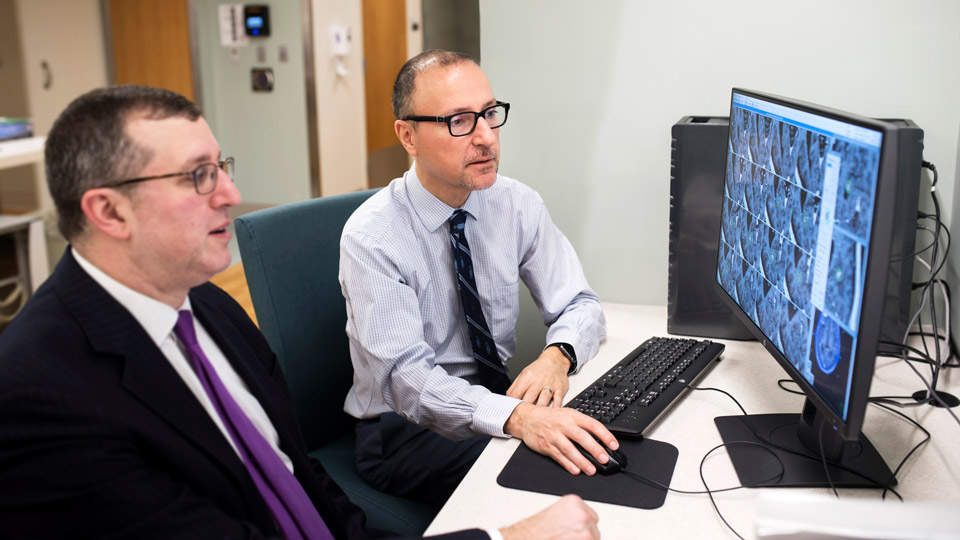Radiation Therapy for Nasopharyngeal Cancer
NYU Langone doctors use radiation therapy—energy beams that destroy cancer cells—to manage nasopharyngeal cancer. Our radiation oncologists use advanced technology to destroy nasopharyngeal cancer while preserving nearby healthy tissue.
For nasopharyngeal cancer that has spread to lymph nodes, the brain, or the skull base, doctors may prescribe chemoradiation. With this approach, a person receives radiation therapy at the same time as chemotherapy, drugs used to destroy cancer cells throughout the body.
Chemotherapy makes cancer cells more sensitive to radiation therapy, helping to destroy more of the tumor. Chemotherapy also helps eradicate cancer cells that may have spread to other parts of the body, such as the lungs, liver, or bones.
Radiation Therapy Planning
Radiation oncologists at NYU Langone use CT scans in conjunction with treatment-planning software to customize radiation therapy. Using CT scan results, the software creates a three-dimensional image of the tumor, nearby lymph nodes, and surrounding structures, including the brain, brainstem, and optic nerve, which runs from the eye to the brain. The CT scan may also produce images of the cochlea, the part of the inner ear that processes sound, and nerves that control speech and swallowing. The resulting image helps doctors deliver targeted radiation doses to the tumor while sparing healthy tissue and important structures.
Other structures doctors may include in this scan are the salivary glands, which produce saliva for chewing and swallowing, as well as swallowing muscles and the jawbones. The thyroid gland, which helps regulate metabolism, may also be included, as may the pituitary gland, which is a pea-sized organ that controls and coordinates the release of hormones responsible for growth, metabolism, and fertility, among other bodily functions.
Intensity Modulated Radiation Therapy
Doctors at NYU Langone typically use intensity modulated radiation therapy to manage nasopharyngeal cancer. With this therapy, the radiation beams come from different directions and are broken into many small, computer-controlled doses of different strengths.
Tailored to the size, shape, and location of the cancer, these “minibeams” enable doctors to deliver high doses of radiation to specific areas while avoiding nearby healthy tissue. Doctors may direct radiation therapy to nearby lymph nodes if they contain cancer. Even if testing shows that the nodes aren’t cancerous, radiation oncologists may target them in case any microscopic cancer cells have spread there.
Radiation therapy is delivered in fractions—typically once daily, five days a week, for seven weeks.
A special imaging technology called cone-beam CT is used before each treatment to ensure that the radiation therapy is delivered precisely. This allows doctors to view the tumor and adjacent critical organs, nerves, and structures, and to adjust the delivery of radiation to reflect changes in body positioning, weight loss, and tumor shrinkage.
Stereotactic Radiosurgery or Gamma Knife Surgery
Physicians at NYU Langone’s Center for Advanced Radiosurgery may use stereotactic radiosurgery, which is also called Gamma Knife® surgery, to manage small nasopharyngeal cancers that extend into the skull base. Despite the name, Gamma Knife® is not a knife but rather a system for delivering precisely targeted radiation treatment.
Working together, neurosurgeons and radiation oncologists use highly detailed MRI or CT images to create a customized treatment plan. Then, the Gamma Knife® system directs multiple highly-targeted radiation beams to the tumor in a single treatment session. Important nearby structures, such as nerves and blood vessels in the skull base, receive only a low radiation dose.

People being treated wear a head frame during the procedure that prevents them from moving.
Gamma Knife® surgery is an outpatient procedure and usually takes only a few hours to complete.
Managing the Side Effects of Radiation Therapy
Common side effects of radiation therapy for nasopharyngeal cancer include inflammation of the lining the mouth and nasopharynx, a stuffy nose, a sunburn-like change to the skin, changes in taste, difficulty swallowing, dry mouth, and temporary hair loss. Radiation therapy may also cause tightening of the muscles in the face, jaw, and neck. Many side effects from radiation therapy are temporary.
To ease discomfort, doctors prescribe medication or refer you to integrative health services. Because dry mouth can lead to tooth decay, NYU Langone dentists are available to help monitor and manage your dental health. In addition, rehabilitation specialists can manage muscle stiffness and help restore swallowing function.
Clinical Trials
An experimental test given before and after radiation therapy may help doctors determine how well the cancer is responding to treatment and decide which additional therapies may be needed.
As part of a clinical trial, doctors take a blood sample from people with nasopharyngeal cancer to measure levels of Epstein-Barr virus (EBV). Lower EBV levels may indicate that the cancer is responding to treatment. Higher levels may mean more treatment is needed.
Doctors may withhold additional chemotherapy if EBV is not detectable, or they may consider prescribing more intensive chemotherapy if elevated EBV levels persist. By measuring EBV levels in blood, doctors can also monitor nasopharyngeal cancer recurrence.
NYU Langone doctors can discuss whether this clinical trial is right for you.
Meet Our Doctors
Perlmutter Cancer Center specialists provide care and support during treatment.
Browse Doctors